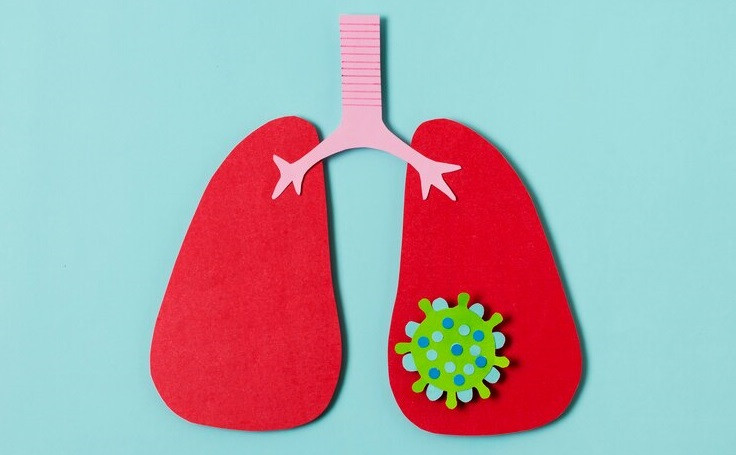Pneumonia and tuberculosis (TB) are sometimes mistaken for the same illness, as they share symptoms such as coughing. However, they are distinct diseases with different treatments. Here, we outline the key differences between pneumonia and TB.
Differences Between Pneumonia and Tuberculosis (TB)
Pneumonia and tuberculosis that attack the lungs are often characterized by the same symptoms, namely cough and short chest. But both of them are actually different infections.
Pneumonia
Pneumonia is a lung infection that may be caused by bacteria, viruses, or fungi. It leads to inflammation of lung tissue and the accumulation of fluid or pus in the lungs.
Generally, bacterial pneumonia is more severe than viral pneumonia, which can sometimes resolve on its own.
Symptoms of pneumonia vary depending on the cause and severity. Common symptoms include:
- High fever (up to 40ºC)
- Cough with yellow, green, or bloody mucus
- Fatigue
- Rapid breathing and shortness of breath
- Rapid heart rate
- Sweating or chills
- Chest pain, especially when coughing or breathing deeply
- Abdominal pain
- Loss of appetite
- Dry cough
- Headache
- Muscle pain
Pneumonia treatment depends on the cause (bacterial, viral, or fungal) and the severity of the disease. Treatment may include:
- Antibiotics for bacterial infections and antifungals for fungal infections. Viral pneumonia typically resolves on its own, but antivirals may be prescribed to alleviate symptoms.
- Oxygen therapy for patients with shortness of breath or breathing difficulty.
- Fluid drainage can be recommended if fluid builds up between the lungs and chest wall.
- Intravenous fluids to prevent dehydration.
Tuberculosis (TB)
Tuberculosis (TB) is an infection caused by the Mycobacterium tuberculosis bacteria. Unlike pneumonia, which typically affects only the lungs, TB can also impact other organs, such as the brain, kidneys, and glands.
TB progresses through three stages:
- Primary infection: The initial infection when TB is first contracted.
- Latent TB: The bacteria remain dormant in the body without symptoms, though a blood test will show a positive result.
- Active TB: Symptoms appear, and the bacteria are actively affecting the body
People with latent TB do not show symptoms, but if a blood test is carried out, they can show positive test results. Active TB symptoms include:
- Severe cough lasting more than two weeks
- Chest pain
- Coughing up blood or phlegm
- Fatigue or weakness
- Loss of appetite
- Weight loss
- Shivering
- Fever and night sweats
TB treatment typically lasts several months, for 4, 6, or 9 months. The bacterias are difficult to control so TB requires a combination of drugs. Common TB medications include:
- Isoniazid
- Rifampicin
- Rifabutin
- Rifapentine
- Pyrazinamide
- Ethambutol
Though both diseases affect the lungs, they are different in nature. TB can spread beyond the lungs to other organs, whereas pneumonia is typically confined to the lungs. Some pneumonia cases, especially viral, can resolve without medical treatment. In contrast, TB requires ongoing, regimented treatment to ensure recovery.
If you experience symptoms of either pneumonia or TB, it’s best to consult a healthcare professional for accurate diagnosis and appropriate treatment. You can also use the consultation feature on the Ai Care app, available in the App Store or Play Store.
Want to learn more about other diseases? Click here!
- dr Nadia Opmalina
Mayo Clinic. Pneumobia. Available from: https://www.mayoclinic.org/diseases-conditions/pneumonia/symptoms-causes/syc-20354204
American Lung Association. Pneumonia Symptoms and Diagnosis. Available from: https://www.lung.org/lung-health-diseases/lung-disease-lookup/pneumonia/symptoms-and-diagnosis
Cleveland Clinic. Pneumonia. Available from: https://my.clevelandclinic.org/health/diseases/4471-pneumonia
Tuberculosis. Mayo Clinic. Available from: https://www.mayoclinic.org/diseases-conditions/tuberculosis/symptoms-causes/syc-20351250
Cleveland Clinic. TUberculosis. Available from: https://my.clevelandclinic.org/health/diseases/11301-tuberculosis












